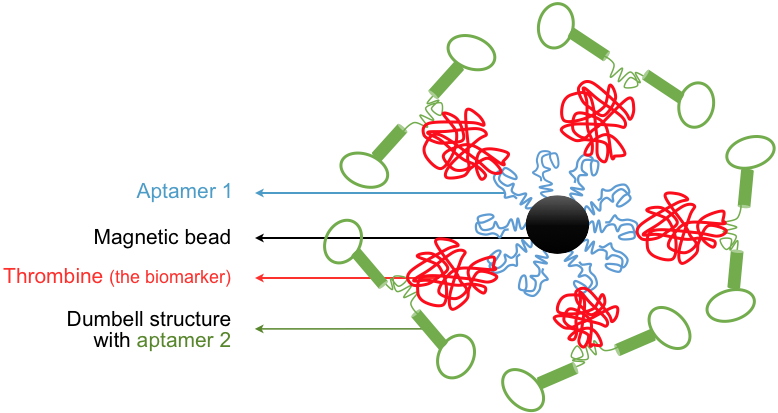Blood biomarkers are molecules that signal the presence of a disease, for example, with high sensitivity and specificity. Their detection is of utmost importance to better detect predictive or early signs of certain diseases. Several techniques exist but the quantification of a target such as a biomarker present at very low concentrations in a complex sample (blood, urine, polluted water, etc.) remains a challenge.
Different techniques have been developed, including ELISA (Enzyme Linked ImmunoSorbent Assay) which uses two different antibodies and an enzymatic amplification. However, ELISA is sometimes limited or ineffective when the target is present at very low concentrations. While enzymatic amplification is linear in time, exponential amplifications based on oligonucleotides (short strands of synthetic DNA or RNA) have been developed and are the basis of the
PCR technique. Two variants of ELISA exist:
-
immuno-PCR where the enzymatic amplification of ELISA is replaced by an exponential amplification of DNA by PCR while retaining the recognition of the biomarker by antibodies, and
-
apta-PCR where the secondary antibody is substituted by an
aptamer to which a short nucleotide sequence is grafted for PCR amplification. However, immuno-PCR requires two antibodies specific to the target of interest and the development of a DNA-conjugated antibody, which makes it complicated and costly. The use of aptamers as a substitute for antibodies makes apta-PCR very interesting, especially in complex environments.
Nevertheless, these two variants have the disadvantages of PCR amplification, namely the need to work at several temperatures and a high sensitivity to inhibitors present in the samples to be studied. Loop-mediated isothermal amplification, or LAMP, represents an interesting alternative. It is one of the most specific and sensitive methods among the isothermal amplifications, it is also less sensitive to inhibitors present in biological samples and has the advantage of being performed at constant temperature.
Researchers at our laboratory [
collaboration] have demonstrated the proof of concept of an apta-LAMP assay using thrombin (a protein involved in blood clotting) as a biomarker. They used two aptamers described to bind to two different epitopes of this protein to form a stable sandwich (
Figure). The test developed is based on a DNA amplification using a dumbbell structure (Patent) requiring only 2 primers instead of 4 or 6. In an original way, the researchers introduced an aptamer sequence at different positions of the dumbbell structure in order to analyze the impact on the amplification and recognition of thrombin. The amplification of these different alters was validated in less than 30 minutes and the quantitative detection of thrombin was achieved with a detection limit of 100 pM and a quantification range of 3 orders of magnitude corresponding to physiological conditions.

The sample in which the presence of a biomarker is searched for (here the thrombin protein) is first brought into contact with magnetic beads on which a first aptamer presenting an affinity with thrombin has been grafted. The dumbbell structure comprising the second aptamer is then added and will form a sandwich with thrombin if it is present in the sample to be analyzed. A LAMP amplification in the presence of 2 primers will then be performed and the target quantified.
This method, which does not require the use of antibodies, can be integrated into a portable medical device and allows the quantification of various biomarkers with a high specificity and sensitivity, from clinical samples, in situations suitable for a so-called bedside analysis. Finally, it opens perspectives in the field of diagnostics, especially for its application to cardiac diseases requiring a rapid diagnosis. It is for this reason that the
Auvergne Rhône-Alpes region supports this research
via the
DEDICATE project.
PCR or
Polymerase Chain Reaction PCR: A DNA polymerization chain reaction that results in its exponential amplification.
Aptamer: A synthetic oligonucleotide, DNA or RNA, capable of binding a specific ligand thanks to its three-dimensional structure. Their selectivity and ligand binding properties allow aptamers to be compared to antibodies.
Collaboration: Microfluidic Systems and Bioengineering Lab of the Technologies for Healthcare and Biology Division, (DTBS) at the Electronics and Information Technology Laboratory of CEA-Grenoble (CEA-Leti).